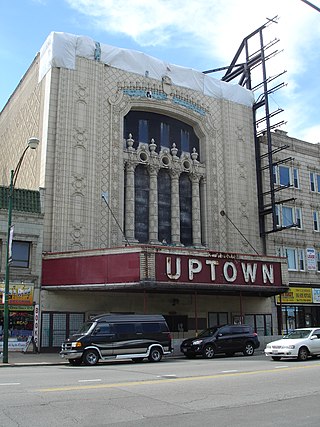
A movie palace is any of the large, elaborately decorated movie theaters built between the 1910s and the 1940s. The late 1920s saw the peak of the movie palace, with hundreds opening every year between 1925 and 1930. With the advent of television, movie attendance dropped, while the rising popularity of large multiplex chains in the 1980s and 1990s signaled the obsolescence of single-screen theaters. Many movie palaces were razed or converted into multiple-screen venues or performing arts centers, though some have undergone restoration and reopened to the public as historic buildings.
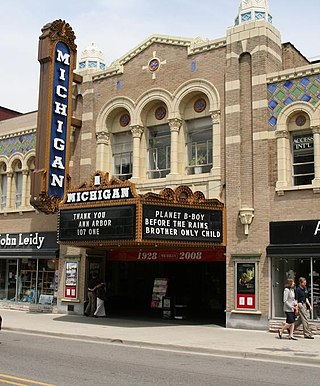
The Michigan Theater is a movie palace in Ann Arbor, Michigan, United States, near the Central Campus of the University of Michigan. It shows independent films and stage productions, and hosts musical concerts.

The Chicago Theatre, originally known as the Balaban and Katz Chicago Theatre, is a landmark theater located on North State Street in the Loop area of Chicago, Illinois. Built in 1921, the Chicago Theatre was the flagship for the Balaban and Katz (B&K) group of theaters run by A. J. Balaban, his brother Barney Balaban and partner Sam Katz. Along with the other B&K theaters, from 1925 to 1945 the Chicago Theatre was a dominant movie theater enterprise. Currently, Madison Square Garden, Inc. owns and operates the Chicago Theatre as a performing arts venue for stage plays, magic shows, comedy, speeches, sporting events and popular music concerts.
Capitol Theater, Capitol Theatre, or CapitolCinema may refer to:

The Fox Oakland Theatre is a 2,800-seat concert hall, a former movie theater, located at 1807 Telegraph Avenue in Downtown Oakland. It originally opened in 1928, running films until 1970. Designed by Weeks and Day, the theatre is listed on the National Register of Historic Places. It was refurbished in the 2000s and reopened as a concert venue on February 5, 2009.
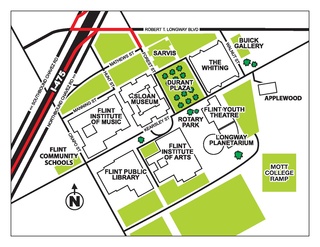
The Flint Cultural Center (FCC) is a campus of cultural, scientific, and artistic institutes located in Flint, Michigan, United States. The institutions located on the grounds of the FCC are the Flint Institute of Arts, Flint Institute of Music, Sloan Museum, Flint Public Library, Buick Gallery & Research Center, Robert T. Longway Planetarium, The Whiting, and the Bower Theatre. The campus and some institutions are owned by Flint Cultural Center Corporation.

The Michigan Theatre at 124 North Mechanic Street in Jackson, Michigan opened in 1930 and was designed by Maurice Herman Finkel. It was listed on the National Register of Historic Places on May 8, 1980, and is undergoing renovations as of 2005.

Uptown Theatre is a currently closed movie palace and concert venue located in the Uptown neighborhood of Chicago, Illinois. Designed by Rapp and Rapp and built by Paschen Bros. contractors, it is one of the many movie palaces built by the Balaban & Katz theatre chain run by A. J. Balaban, his brother Barney Balaban, and their partner Sam Katz.

The Somerville Theatre is an independent movie theater and concert venue in the Davis Square neighborhood of Somerville, Massachusetts, United States. Over one hundred years old, the Somerville Theatre started off as a vaudeville house and movie theater. The theater has since transitioned and now operates as a live music venue and first-run movie theater. As a music venue, the theater has played host to many historic concerts, including the first of the two Last Dispatch concerts, two shows by Bruce Springsteen in 2003, and a performance by U2 in 2009. Recent live performances have included Ryan Adams & the Cardinals, Cursive, Norah Jones, The Jonas Brothers, Joan Baez, and the John Butler Trio.

John Adolph Emil Eberson was an Austrian-American architect best known for the development and promotion of movie palace designs in the atmospheric theatre style. He designed over 500 theatres in his lifetime, earning the nickname "Opera House John". His most notable surviving theatres in the United States include the Tampa Theatre (1926), Palace Theatre Marion (1928), Palace Theatre Louisville (1928), Majestic Theatre (1929), Akron Civic Theatre (1929) and Paramount Theatre (1929). Remaining international examples in the atmospheric style include both the Capitol Theatre (1928) and State Theatre (1929) in Sydney, Australia, The Forum (1929), Melbourne, Australia), the Lewis J. Warner Memorial Theater (1932) at Worcester Academy in Worcester, Massachusetts and Le Grand Rex.


An atmospheric theatre is a type of movie palace design which was popular in the late 1920s. Atmospheric theatres were designed and decorated to evoke the feeling of a particular time and place for patrons, through the use of projectors, architectural elements and ornamentation that evoked a sense of being outdoors. This was intended to make the patron a more active participant in the setting.
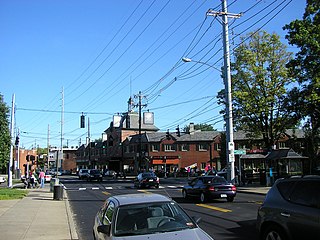
The Schuster Building is a mixed-use structure at the intersection of Bardstown Road and Eastern Parkway in the Highlands area of Louisville, Kentucky. Added to the National Register of Historic Places in 1980 as a "significant example" of Colonial Revival architecture as applied to commercial buildings, the Schuster building is one of Louisville's most prominent examples of that style.

The Majestic Theatre is a performing arts theater in the City Center District of Downtown Dallas. It is the last remnant of Theater Row, the city's historic entertainment center on Elm Street, and is a contributing property in the Harwood Street Historic District. The structure is a Dallas Landmark and is listed on the National Register of Historic Places.

The Capitol Theatre is a historic theatre located in the village of Port Chester, Westchester County, New York. It was designed by noted theater architect Thomas W. Lamb (1871–1942) and built in 1926. The 1,800-seat facility operates as a concert venue, hosting musicians and occasionally comedians, as owned and operated by NYC-based concert promoter Peter Shapiro. The Capitol Theatre has had a long history, with tenures as a movie theater and catering hall, in addition to hosting concerts.

The Paramount Theater is an historic theater located at 1676-1708 Main Street in Springfield, Massachusetts. Built in 1926 out of part of the grand Massasoit House hotel at a cost of over $1 million, the Paramount Theater was the most ornate picture palace in Western Massachusetts. As of 2011, The Paramount is in the midst of a $1.725 million renovation to once again become a theater after decades as a disco and concert hall,, when it was the center of Springfield's club scene. In 2018 the building's owners, the New England Farm Workers Council, announced plans to redevelop it in tandem with a new adjacent hotel building. In a push to renovate the Paramount along with Holyoke's Victory Theater, in October 2018, the administration of Massachusetts Governor Charlie Baker announced a $2.5 million grant to assist the project, on top of a $4 million federal loan guarantee. Pending finalizing funding for the combined restoration and new hotel, no construction timeline has been presented as of 2023.

The State Theatre is a Spanish-styled atmospheric theatre in Kalamazoo, Michigan, designed by renowned architect John Eberson. The State was built for W.S. Butterfield Theatres in 1927, and remains in operation today, presenting live shows. The theatre was listed on the National Register of Historic Places in 2021.
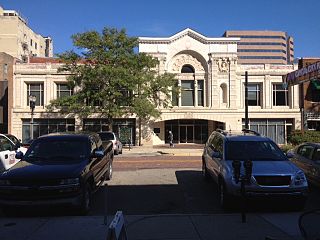
The Strand Theatre and Arcade, also known as the Michigan Theatre and Arcade, is a former theatre building located at 211–219 South Washington Avenue in Lansing, Michigan. It was listed on the National Register of Historic Places in 1980.

The Maltz Opera House is a theater in Alpena, Michigan, named after Alpena banker George L. Maltz. The Maltz is currently under restoration to its 1930s-era appearance, and is expected to be listed on the National Register of Historic Places.




















